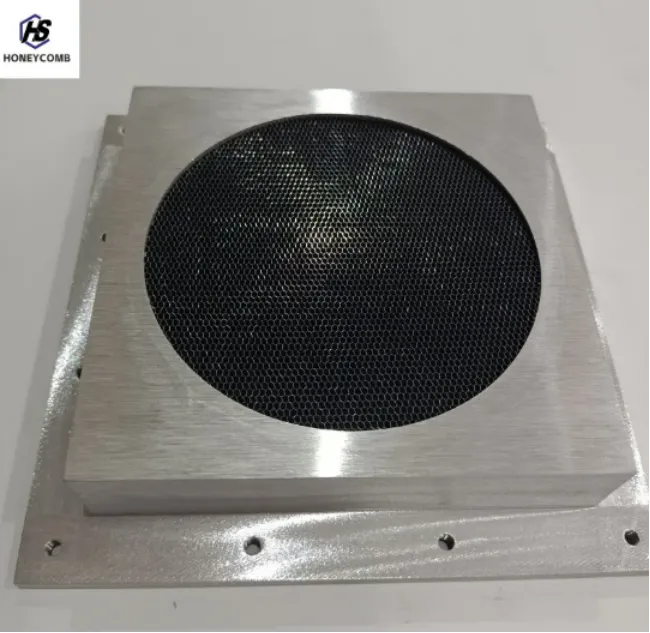
- Afrikaans
- Albanian
- Amharic
- Arabic
- Armenian
- Azerbaijani
- Basque
- Belarusian
- Bengali
- Bosnian
- Bulgarian
- Catalan
- Cebuano
- China
- China (Taiwan)
- Corsican
- Croatian
- Czech
- Danish
- Dutch
- English
- Esperanto
- Estonian
- Finnish
- French
- Frisian
- Galician
- Georgian
- German
- Greek
- Gujarati
- Haitian Creole
- hausa
- hawaiian
- Hebrew
- Hindi
- Miao
- Indonesian
- Italian
- Japanese
- Javanese
- Malay
- Persian
- Portuguese
- Punjabi
- Russian
- Spanish
- Swahili
- Telugu
- Vietnamese

The Power of Honeycomb Ventilation in Modern Design
Honeycomb ventilation is an essential aspect of modern engineering, combining functionality with innovation. From honeycomb vent covers к EMI RFI shielded waveguide air vents, honeycomb materials are revolutionizing industries by offering efficient airflow, energy savings, and protection from electromagnetic interference. Whether you're designing a new tech product, enhancing a building’s HVAC system, or seeking high-performance solutions, honeycomb air vents are integral in achieving the desired results. This article explores the advantages and uses of these innovative honeycomb-based solutions.
Honeycomb Vent Cover: Protecting and Enhancing Airflow
A honeycomb vent cover serves as an essential component for controlling airflow in various applications, from electronic devices to industrial machinery. The unique structure of a honeycomb vent cover is designed to promote optimal airflow while preventing dust, debris, or harmful particles from entering sensitive equipment. These covers are ideal for environments where clean and uninterrupted airflow is critical, such as in telecommunications or computing devices.
The honeycomb design of these vent covers ensures that air can flow through efficiently without compromising protection. The design helps distribute airflow evenly, minimizing noise and vibrations caused by air pressure fluctuations. Whether you're looking to cool sensitive electronics or maintain a balanced indoor environment, a honeycomb vent cover provides both functionality and durability.
By utilizing honeycomb vent covers, industries can extend the lifespan of their equipment by preventing overheating and reducing wear from contaminants. The vent covers are also lightweight and corrosion-resistant, ensuring that they remain effective over time, even in harsh environments. Whether for indoor or outdoor use, a honeycomb vent cover offers an effective solution to maintaining optimal airflow.
EMI RFI Shielded Waveguide Air Vents: Safeguarding Sensitive Electronics
EMI RFI shielded waveguide air vents are an essential part of modern communication systems and electronic equipment. Electromagnetic interference (EMI) and radio frequency interference (RFI) are significant concerns in many industries, particularly in telecommunications, aerospace, and defense. The function of EMI RFI shielded waveguide air vents is to protect sensitive electronics from these harmful interferences while allowing for proper ventilation.
These specialized air vents incorporate advanced shielding techniques to prevent electromagnetic waves and radio frequencies from entering or escaping the enclosure. With EMI RFI shielded waveguide air vents, engineers can ensure that their equipment maintains optimal performance without being disrupted by external signals. This protection is especially important for military-grade technology, medical devices, and communication systems where precision and reliability are paramount.
In addition to their shielding capabilities, these air vents maintain airflow and cooling properties. The сотовая структура within the EMI RFI shielded waveguide air vents ensures that the air circulates properly, preventing overheating while keeping unwanted electromagnetic disturbances at bay. These air vents are indispensable in high-tech environments where both cooling and shielding are critical for performance and safety.
Honeycomb Ventilation: Efficient Airflow for Better Performance
Honeycomb ventilation is a design that utilizes a honeycomb structure to manage airflow more effectively. The benefits of honeycomb ventilation extend beyond just the ability to move air. It allows for more efficient energy use and can drastically improve the thermal management of various systems. Whether for industrial machinery, HVAC systems, or computing hardware, honeycomb ventilation provides a smarter, more energy-efficient solution.
The design of honeycomb ventilation allows for increased surface area for airflow, which helps cool down sensitive components or spaces. By using honeycomb structures, engineers can control airflow direction, volume, and speed to suit the needs of the application. This makes honeycomb ventilation ideal for environments with high heat output, like data centers, power plants, and vehicle engines.
One of the key advantages of honeycomb ventilation is its ability to provide uniform airflow distribution. This even distribution minimizes hot spots, which can lead to system failure or inefficiency. Additionally, the structure allows for higher strength-to-weight ratios, making the materials more durable and lightweight, reducing the overall cost of the system while improving performance.
Honeycomb Air Vent: Maximizing Cooling Efficiency
A вентиляционное отверстие в виде сот is a specialized type of ventilation system that uses a honeycomb-shaped core to promote optimal airflow. These air vents are designed to efficiently manage and control the movement of air in spaces that require constant ventilation, such as in industrial applications, electronics, and automobiles.
The primary advantage of a вентиляционное отверстие в виде сот is its ability to handle large volumes of air with minimal resistance. The honeycomb structure allows air to flow freely through the vent while maintaining consistent pressure, which maximizes the cooling capabilities of the system. This feature is especially crucial in environments like computer servers, where excessive heat buildup can damage sensitive equipment.
In addition to its cooling properties, honeycomb air vents are highly customizable. Depending on the needs of the application, manufacturers can adjust the size and spacing of the honeycomb cells to meet specific airflow requirements. This flexibility makes honeycomb air vents ideal for a wide range of industries, including electronics, HVAC, automotive, and more.
Honeycomb Vent Cover FAQs
What is the purpose of a honeycomb vent cover?
A honeycomb vent cover ensures efficient airflow while protecting sensitive equipment from dust, debris, and other particles. It helps maintain proper ventilation, preventing overheating and extending the lifespan of devices.
How do EMI RFI shielded waveguide air vents protect electronics?
EMI RFI shielded waveguide air vents prevent electromagnetic and radio frequency interference from disrupting electronic equipment. These air vents allow for proper ventilation while maintaining the integrity of sensitive systems by shielding them from external interferences.
What are the benefits of honeycomb ventilation in industrial applications?
Honeycomb ventilation is highly effective in improving airflow efficiency, ensuring even heat distribution, and reducing energy consumption. It helps maintain optimal temperatures in high-performance systems, reducing the risk of overheating.
How do honeycomb air vents maximize cooling efficiency?
Honeycomb air vents are designed to allow large volumes of air to flow through with minimal resistance. Their structure ensures consistent pressure and airflow, making them ideal for cooling sensitive equipment in industrial and electronic applications.
Can honeycomb air vents be customized for different needs?
Yes, honeycomb air vents are highly customizable. The size and spacing of the cells in the honeycomb structure can be adjusted to meet specific airflow and cooling requirements, making them versatile for various applications.
Honeycomb-based solutions such as honeycomb vent covers, EMI RFI shielded waveguide air vents, honeycomb ventilation, и honeycomb air vents are changing the landscape of modern engineering. These products offer enhanced airflow management, protection from electromagnetic interference, and improved cooling efficiency. They are integral in applications ranging from electronics to industrial machinery and beyond.
If you're looking for high-performance, durable, and energy-efficient ventilation solutions, honeycomb products are the way to go. Visit our website today to explore our range of honeycomb solutions and find the perfect product for your needs. Don’t wait—enhance your systems with the best in honeycomb technology now!

Категории продуктов
-
Why Vented Aluminum Honeycomb Is Leading the Way in Shielding and Ventilation SolutionsНовостиJul.18,2025
-
Why Stainless Steel Honeycomb Panel is the Ultimate Choice for High-Tech Shielding and ProtectionНовостиJul.18,2025
-
Why Honeycomb Strips Are Revolutionizing High-Speed Sealing SolutionsНовостиJul.18,2025
-
Shielded Glass Innovation Powers the Future of Electromagnetic ProtectionНовостиJul.18,2025
-
Precision Starts Here: Revolutionizing Airflow Control with Honeycomb Wind Tunnel SolutionsНовостиJul.18,2025
-
Elevate Industrial Performance with Precision-Engineered Steel Honeycomb Core SolutionsНовостиJul.18,2025
-
Vented Aluminum Honeycomb: A Smart Shield for Airflow and EMI ControlНовостиJul.11,2025















